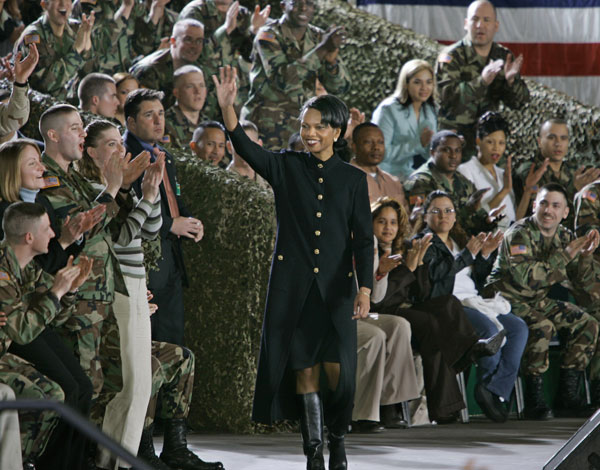Weapons of Mass Seduction
Foreign Policy |
By PARAG KHANNA
Earlier this year, on her first European tour as U.S. secretary of state, set tongues wagging by strutting into Germany wearing a powerful, all–black ensemble: tall boots, long, military–style jacket, above–the–knee skirt. The backlash to such coverage was not far behind. “I don’t recall any commentary about Colin Powell’s fashion sensibilities,” said one observer. “Do we really want our politicians to face the same scrutiny as our musicians, actors, and Paris Hilton?” asked another. The truth is, in geopolitics, fashion does matter—for men as well as women. Leaders are inevitable symbols of their respective nations, and their fashion choices, with all their subtlety, increasingly shape and reinforce global perceptions, for good and ill.
As if to combine the great military strategist Sir Basil Liddell Hart’s writings on tank maneuvers and high fashion of a century ago—yes, he was an authority on both—Rice’s charm offensive reminded Europe’s onlookers that the United States is a force to be reckoned with. Robin Givhan of the Washington Post said that Rice “looked as though she was prepared to talk tough, knock heads and do a freeze–frame ‘Matrix’ jump kick if necessary.” If the newly appointed top diplomat wanted to show the world that she—and the United States, by extension—is up to the simultaneous challenges of a second term, a war on terror, and an ongoing morass in Iraq, she couldn’t have dressed more appropriately. Rice may have learned a thing or two about sartorial symbolism from her boss. U.S. President George W. Bush knows that it is often not a leader’s own apparel that matters, but the clothes he asks others to wear on his turf that can shift the balance of power. At last summer’s G–8 summit at Sea Island, Georgia, French President Jacques Chirac appeared overdressed in a double–breasted suit and crisp red cravat; others were in jeans and sports shirts. As Kenneth Dreyfack pointed out in the International Herald Tribune, “That’s the very reason that Bush, like his predecessors, tries to impose casual wear for important encounters between world leaders. Purportedly designed to put the participants at ease, it actually makes them uncomfortable and, more important, puts them at a disadvantage. By requiring them to modify a highly personal accouterment, the clothing they wear, foreign White House guests are accepting White House ground rules even before they sit down to talk.” Likewise, no amount of protocol could stop the sheepish grins of 21 world leaders at last year’s Asia–Pacific Economic Cooperation summit in Santiago, Chile: In a bow to tradition, they all wore colorful alpaca ponchos—and the diplomatic playing field was immediately leveled. Chirac is not alone in his embarrassment. Just days after the second Bush inauguration in January, Vice President Dick Cheney committed the first major fashion faux pas of 2005. He showed up at the 60th anniversary commemoration of the liberation of the Nazi death camp Auschwitz wearing, as Givhan put it, the kind of attire one normally puts on “to operate a snow blower.” Whereas other world leaders wore dark overcoats and dark shoes, Cheney donned a drab olive parka with a fur–trimmed hood, brown hunting boots, and a cheap ski hat. Clearly, American diplomacy still suffers from too much preaching and not enough prep. Is it any wonder the rest of the world doubts America’s diplomatic sincerity? Conversely, politicians’ fashions can also garner much–needed sympathy and awareness for their countries. Although Afghanistan’s president, Hamid Karzai, is often lauded for his stylish astrakhan cap and traditionally elegant coats, he insists that he is not simply fashionable for fashion’s sake. Through his sartorial style, weaving various tribal symbols into flowing capes, Karzai is changing international perceptions of Afghans and reinforcing a sense of national unity. When former Gucci designer Tom Ford labeled Karzai the “best–dressed man in the world” in 2002, he helped push the embattled leader into the spotlight, winning international attention for his nation’s plight from fashion critics and foreign donors alike. If you don’t believe that fashion can be deeply political, playing to national sympathies and comfortable historical myths, just look at what’s going on in Pakistan. When Pakistan’s history books were Islamicized in the 1970s and 80s, the country’s founding father, Mohammed Ali Jinnah, was portrayed wearing a traditional sherwani instead of his preferred Savile Row suits of a London–trained barrister. It’s fitting, then, that the one–time captain of Oxford University’s cricket team, Imran Khan, now wears similarly traditional kurtas (pajama–style clothing) in an attempt to build street credibility for his self–styled Justice Movement party. Having abandoned his cozy ties to President Gen. Pervez Musharraf, Khan no doubt hopes his cricket victories will translate onto Pakistan’s political playing field. Of course, one man’s street cred is another’s shoddy unprofessionalism. Pakistani Citibank executive–turned–prime minister Shaukat Aziz demands that his cabinet ministers dress Western business formal at meetings, hoping the right clothes will make his core team more efficient. (The Karachi stock exchange has been on an upswing ever since.) For decades, Cuba’s strongman Fidel Castro rebelled against the hegemony of Western fashion, but even he now sports a crisp navy suit to meet with the pope and attend international summits. Elsewhere, the suit and power tie may be a symbol of transcending colonial animosities. Isaac Maria Dos Anjos, Angola’s ambassador to South Africa, recently gave a stirring speech on reconciliation, in which he remarked, “After five hundred years of colonialism, I now wear a suit and tie. That is enough. I don’t want another five hundred years of African colonialism to be taught how to lose the tie and wear clothes from the Democratic Republic of [the] Congo or anywhere else. I keep my tie and move on.” Sartorial symbolism pervades high diplomacy. So much so, in fact, it now seems as though where you stand depends not on where you sit, but rather on what you wear.
